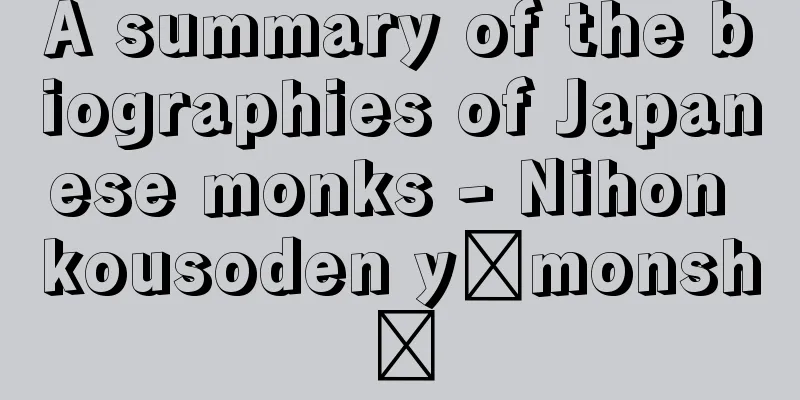Inheritance of the family headship

|
This refers to an inheritance in which one person inherits the status and assets of the head of the household (single inheritance). Modeled mainly on the inheritance laws of the samurai class in feudal times, it was adopted in the Civil Code (Old Civil Code) enacted in 1898 (Meiji 31), and was central to the family system until the current Civil Code (1947) was enacted after World War II. After the war, the family system was abolished as it was against the principles of the new constitution, and the succession of the family head was also abolished. Inheritance of the family head could begin while the deceased was still alive, in cases such as when the head retired, lost his/her nationality, or married a female head of the family. There was only one person who could inherit the family head, and first, the closest direct descendant was chosen - between a man and a woman, the man, and between an older and a younger person, the former, so the eldest son usually inherited. If there were no direct descendants, the person to inherit would be someone designated by the deceased, or someone selected by a certain selector from among certain family members. Another major difference from modern inheritance is that the succession to the family head was not only the succession of the family head's assets, but also the succession of the family head's status (status succession). In addition, the presumptive heir to the family head (an heir who is a direct descendant of the deceased) was not allowed to renounce the inheritance. Even at that time, when a family member other than the family head died, a joint inheritance law similar to the current inheritance law (called inheritance of an estate as opposed to inheritance of the family head, which is called inheritance in the current Civil Code) was carried out. [Yasuyuki Takahashi] [Reference] |Source: Shogakukan Encyclopedia Nipponica About Encyclopedia Nipponica Information | Legend |
|
戸主(家の長)の身分と財産とを1人の人が受け継ぐ形(単独相続)の相続をいう。主として封建時代の武士階級の相続法に範をとって、1898年(明治31)に制定された民法(旧民法)で採用されたもので、第二次世界大戦後、現行民法(1947)が制定されるまでの、家の制度の中心をなすものであった。戦後、家の制度が新憲法の理念に反するものとして廃止されたのに伴い、家督相続も廃止された。 家督相続は、戸主が死亡した場合のほか、戸主の隠居・国籍喪失、入夫婚姻(女の戸主との婚姻)など、被相続人の生存中に相続が開始されることがあった。家督相続人となる者は1人で、まず直系卑属のうち、親等の近い者、男と女では男、年長者と年少者では前者が選ばれ、したがって普通は長男が相続した。直系卑属がない場合には、被相続人の指定した者、一定の家族のなかから一定の選定権者が選定した者などが相続することになっていた。 家督相続は、戸主の財産を承継するだけでなく、戸主の身分をも受け継ぐ(身分相続)とされていた点も現在の相続とは大きく異なる。また、法定推定家督相続人(被相続人の直系卑属である相続人)は相続を放棄することは許されなかった。なお、当時においても、戸主以外の家族が死亡した場合には、現在の相続法と同じような共同相続法(家督相続に対して遺産相続とよばれ、現行民法では相続という)が行われていた。 [高橋康之] [参照項目] |出典 小学館 日本大百科全書(ニッポニカ)日本大百科全書(ニッポニカ)について 情報 | 凡例 |
Recommend
Pflanzenbiologie
…The word ecology was coined in 1895 by Miyoshi M...
Cell differentiation
During the process of individual development, spec...
《Diversarum artium schedula》 (English notation) Diversarum artium schedula
…He is considered to be the same as the metalwork...
cartoni animati (English spelling) cartonianimati
…When a competition was held for a cartoon fresco...
Greater Pied Kingfisher
A bird of the order Coraciiformes and family Alced...
Tambov
The capital of Tambov Oblast in western Russia. It...
Dokai Bay - Dokaiwan
A bay in the northern part of Fukuoka Prefecture,...
Pulsating current - Myakuryu
〘Noun〙① A flow in which the direction of flow is c...
Sangyōchi - Sangyōchi
An area where a triple trade association (a type ...
Pretrial detention - Miketsu Koryu
The same as detention. Since detention is given to...
Genus Rock Hyrax - Rock Hyrax
...The lifespan of a captive specimen has been re...
Knife - naifu (English spelling) knife
A knife is a blade used primarily for cooking and...
Hosshoji-ryu
This style of calligraphy was started by Fujiwara...
Pantelleria Island (English spelling)
A volcanic island located in southern Italy betwee...
Retinal
…It is easily oxidized by atmospheric oxygen. Car...









